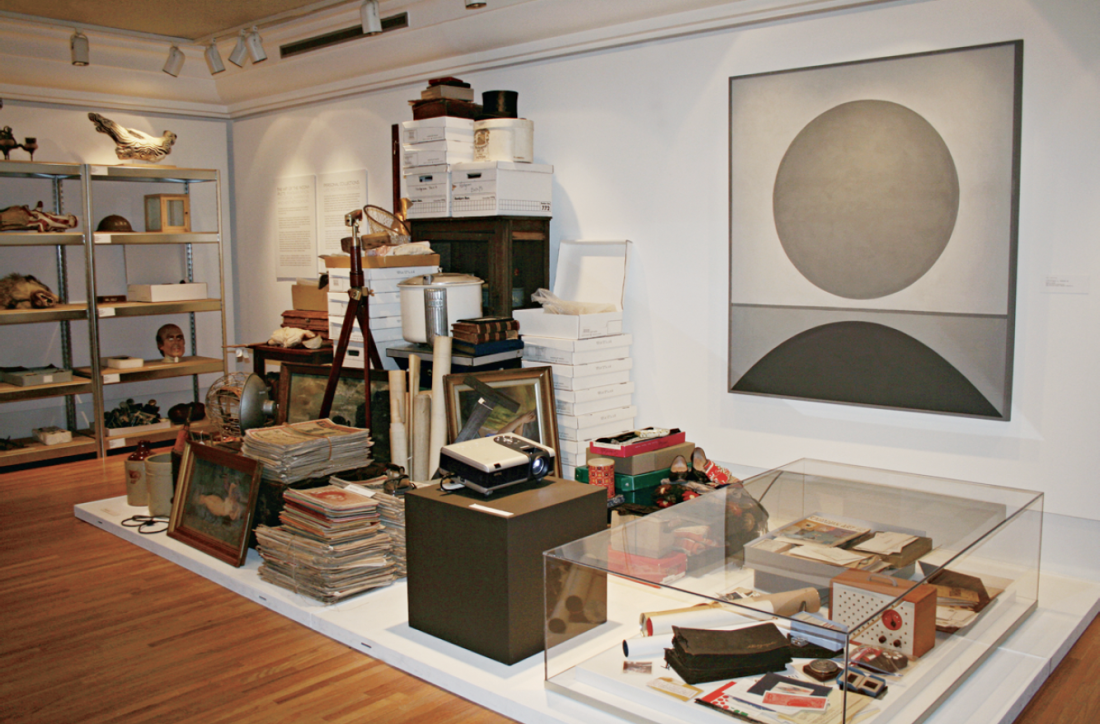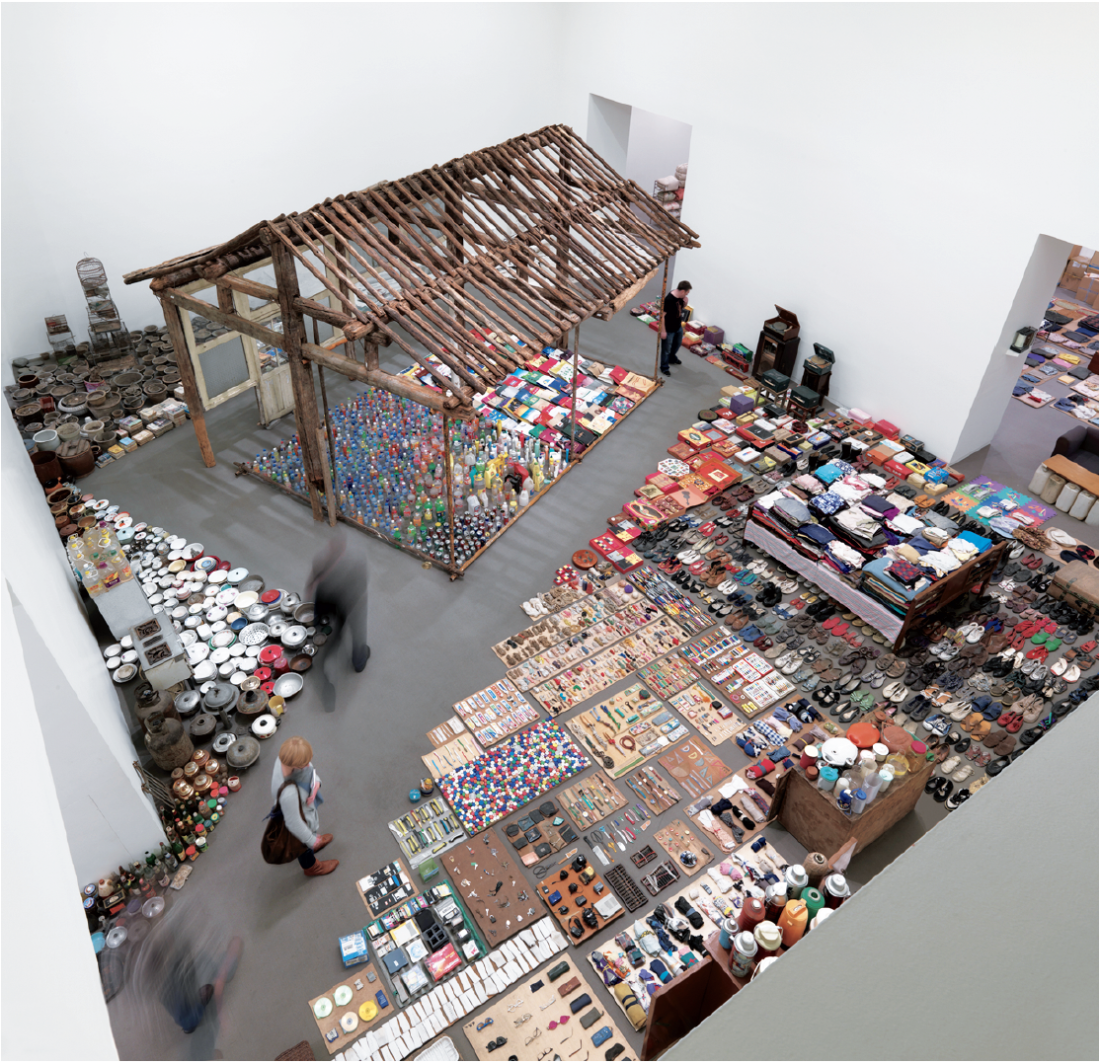“Waste Not” and “Fragmented History: Objects and Meaning”
Karl Marx pondered in Das Kapital how human analysis could transform an apparently banal object into “a very strange thing, abounding in metaphysical subtleties and theological niceties.” What would that authority on commodity fetishism make of today’s stormy relationship between humans and their everyday possessions? To help us triage the endless stuff we accumulate, we collectively embrace reality television, community-college workshops and—most ironically—more objects (self-help books, sorting trays, storage bins, and on and on). That’s beyond metaphysical: it’s meta-organizational.
Two recent Vancouver exhibitions that deal with this subject are diametrically opposed in scale and profile, yet uncannily similar in evoking the metaphysical subtleties of what can broadly be called “stuff.” The first, “Waste Not,” is Beijing artist Song Dong’s internationally travelling exhibition of his late mother’s possessions, installed at the Vancouver Art Gallery. The second, “Fragmented History: Objects and Meaning,” is a compact one-off exhibition at the West Vancouver Museum, culled largely from the estates of prominent local artists. But both exhibitions suggest that the connection of living beings to inert objects is vastly more complex than it may seem at first sight.
“Waste Not” quite literally unpacks the contents of Song Dong’s family home over its 40-year history. Bottles and bottle-caps, textiles, toothpaste, shoes, soap, skeins of wool, pots, pans, pitchers and—my personal favourite—dozens of old stuffed animals, face-down and asplay on cardboard boxes like shootout victims in a Coen Brothers’s movie.

Installation view of the Collecting Residual Objects: Value and the Display of Secondary Material section of “Fragmented History: Objects and Meaning” at the West Vancouver Museum, 2010. Unfinished painting, drawing and painting implements and studio equipment belonging to B C Binning. Gift of the Estate of Jessie Binning, West Vancouver Museum Collection; an assortment of drawing implements, architectural tools of Hugh Hodgson and personal items of Beatrice Hodgson. Gift of the Hodgson family Estate, West Vancouver Museum Collection. Grey painting in background: B C Binning, Untitled, 1968–69, acrylic on canvas, 122 x 140 cm. Gift of the Estate of Jessie Binning. Collection of the West Vancouver Museum.
At first glance, it seems like an ocean of stuff—and yet considering this exhibition comprises most of the material objects of a family of four acquired over four decades, it is really not much stuff at all compared with North American consumption patterns. And much of the stuff actually presents an ecological and economical frame of mind, with objects kept for recycling into other uses or for possible future scarcities.
The stuff is not consciously aestheticized, insists Daina Augaitis, senior curator at the VAG —and yet it’s jaw-droppingly beautiful, placed so carefully here in a systematic context. With like objects grouped together, the whole assemblage becomes a kind of bas-relief mosaic on the gallery floor, recounting an epic tale of family life.
Like “Waste Not,” much of the material of “Fragmented History” is an arrangement of everyday possessions—pens, old magazines, envelopes, bobbins, fire ax, top hat. But because of their careful composition, the serenity of the museum context and the very act of being selected, the objects project a mystique. Scant years ago, many of the objects on display would have filled the contents of local junk drawers and closets. Positioned carefully in sculptural installations (by Anna Wilkinson and Liza Montgomery under the direction of West Vancouver Museum curator Darrin Morrison), they acquire the resonance of a collection of semi-precious stones or artefacts. The strategic placement of banal red objects together imbues them with aesthetic appeal—suddenly some everyday junk becomes a studied composition, doubly so when placed across from an eye-popping, bright red Joan Balzar canvas.
A notable characteristic of both exhibitions is their deliberate avoidance of explanation and labels, even for those items that turn out to be saturated with personal meaning. Embedded in the piles of objects in the “Fragmented Histories” exhibition are the fountain pen of artist B C Binning and the top hat of architect Hugh Hodgson, worn on his wedding day. And, no doubt, many objects saturated with emotional histories now unknown to anyone, including the curators. The contents of “Waste Not” embody a similarly discreet series of personal histories. Among an artful composition of metal, plastic and earthenware bowls is a bowl handmade by the artist’s own father. Elsewhere, we see in the rows of well-used footwear a pair of small black shoes that might have belonged to a child—but in fact belonged to Song Dong’s grandmother, one of the last generation of Chinese women to grow up with bound feet in the fashion of the time. And, amid a field of neatly folded garments is a scraggly, faded yellow, toddler-size shirt— a hand-me-down from his big sister that the artist was forced to wear so many years ago, and his most detested article of clothing.

Song Dong, installation view of “Waste Not” at the Vancouver Art Gallery, 2010. Photograph: Trevor Mills, Vancouver Art Gallery.
How do we know all this? I only know about the poignant family connections to those cited objects because Augaitis pointed them out during a walk-through of the exhibition. And at the West Vancouver Museum, the provenance of Binning’s pen and Hodgson’s hat is only mentioned in the accompanying text material, not in any exhibit labels. Both exhibitions are installed in such a way that you behold the objects without the interference of historic detail.
With no didactic details for such emotionally loaded objects, the viewer is spared the burden of applying predetermined “meaning” to them and is free instead to revel in the metaphysical subtleties that hover around each object. In the most poignant instance in “Waste Not,” an eight-foot-high steel birdcage towers over the low-lying objects around it. Its verticality and its transparency—or its emptiness—suggest all sorts of things: a beacon, memorial tower, abandoned lighthouse or scarecrow. But Augaitis shared another of the artist’s personal history, this one more charged than all the others: this birdcage represented both the mother’s great joy—her beloved birds she nurtured there—and also how she met her sudden death, accidentally falling while adjusting the cage from up high.
In an accompanying essay titled “Healing through Remembering,” Song Dong points out that in ancient Chinese thought, rituals involving tangible objects are sought to preserve the memory and ultimately the soul of the deceased. Objects evolve from their immediate utilitarian value to a more timeless use as vehicles for preserving and activating memory. That culturally specific condition permeates the contents of “Waste Not.” By contrast, the accompanying text of “Fragmented Histories” acknowledges the importance of individualism in Western society and how it confers a sense of importance on the residual objects within the process of cultural creation. Yet both installations speak loudly and uncannily alike about the object as emotional receptacle. Human nature, it would seem, is ultimately more powerful than any regional culture. ❚
“Waste Not” was exhibited at the Vancouver Art Gallery from October 2, 2010, to January 16, 2011. “Fragmented History: Objects and Meaning” was exhibited at the West Vancouver Museum from September 14 to October 16, 2010.
Adele Weder writes on art and architecture for publications across North America. She divides her time between Vancouver and Haida Gwaii.

